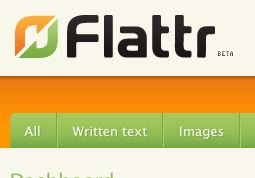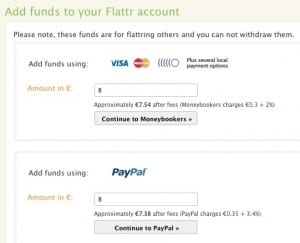Flattr Experiment: Trying a New Business Model
One of the main goals of PT is to help content creators exploit their work to whatever goals they desire, whether it is money, recognition or something else altogether.
When it comes to making money with content, piracy has made earning money from selling copies of content much more difficult but a lot of new business models are being proposed to help content creators earn at least some revenue from their work.
One such business model is being offered up by Peter Sunde, who is best known for his earlier site, The Pirate Bay. The business model is called Flattr and, according to the site, it is a way for content creators to earn money from their content and those who wish to pay to get past the “cost of action” problem that prevents many from pulling out their credit card.
A combination of a micropayment system and a donation platform, all with a Digg-like interface, Flattr aims to make it easy for users to donate money to sites and creators they like, all while keeping their monthly costs flat.
As part of this spirit of trying out new business models, I have decided to give Flattr a 30-day run here on Plagiarism Today. At the same time, I’ll add money to my Flattr account and participate as a user as well. The goal is to see how well Flattr works, how much money (if any) is generated and what the reaction is.
I’m hoping that the results are very interesting.
What is Flattr
The name Flattr is a Web 2.0 spelling of the word “Flatter”, which means to give praise. The idea of the service is to overcome the problem of accepting donations on your site.
The problem is simple, smaller donations are not possible due to transaction costs and larger donations usually can’t be justified by the donor. This means that people who would gladly pay a small amount for a blog post they enjoy, say 25 cents, can’t.
What Flattr does is have users set up a recurring monthly payment to their account, usually a modest amount like $10. As they surf the Web and find content they like, they click the Flattr button next to it (PT’s is above) and that gives that creator 1 Flattr. At the end of the month a user’s money is divided up among all the creators he or she Flattred.
So, going back to the example of $10 per month, if that user Flattrs just one person, that creator receives $10. If he or she Flattrs 100, each person receives 10 cents. The more things you Flattr, the less each Flattr is worth but the amount actually paid never changes.
It is an interesting idea for creators and one I’ve been encouraged repeatedly to test. So I applied for a beta invite and was recently accepted.
Giving Flattr a Try
The plan is simple, I am going to run Flattr on this site for 30 days (maybe a bit longer depending on how the cycles work) and will report back on what I find. Meanwhile, I will also be participating as a user, putting in a small amount of money into my account and Flattring other sites that have the button.
At the end of the experiment, I’ll evaluate keeping it on my site and continuing to use it as a Flattrer. Though I am not horribly optimistic, largely because it is a beta product and not many people seem to be using it, I want to give it a fair shot.
Once the test has been concluded, any money have made beyond what I put into the system during the test period, if any, will be donated to charity (I’ll let you guys decide the charity).
So, for at least the next few weeks, be aware of the Flattr button on the site itself and in the RSS feed. If you are a Flattr user, feel free to donate and, if you’re not and want to, it only takes a moment to sign up.
Early Thoughts
Though I can’t comment on how much money the system makes or how many sites I Flattr, I can talk about the process of opening up an account.
My experience in setting up an account was, unfortunately, not very good. Though the process of registering for a beta invite, receiving it and signing up for an account went smoothly, not much else has.
First, my attempts to add funds to my account via PayPal were thwarted. It appears Flattr uses the UK PayPal system, which makes sense as the company is based in Sweden, but my U.S. account did not work well with it. As such, I had to create a temporary PayPal secure card to take the money out via their credit card system.
This, however, may be for the best as the card expires in 30 days, making it so that Flattr can not remove any more funds unless I take the time to add a more permanent card.
It is also worth noting that the process of adding money is difficult and awkward. You don’t simply pick an amount to have in your account but rather you select the amount you want to pay and Flattr tells you how much that equals. While not terrible and definitely understandable, it took me a few tries to find the amount I wanted to actually add.
With that out of the way, adding the button the site was also a bit of a hassle. My first attempt to automatically insert the button ruined the front page of the site by, apparently, taking away my custom-written excerpts. I added the button by hand using the line of PHP provided but it took some work to format it right, thus the ugly inline CSS code in the site right now (I will integrate it into the CSS file later, if it becomes more permanent).
Also, it is worth noting that, for your Flattr buttons to become active you have to first add money into your account. Otherwise, they are labeled as “inactive”. This was only a problem due to the aforementioned payment issues.
All in all, it took between 60 and 90 minutes to get Flattr up and running both as a user and as a creator. However, I have the buttons working on this site and a token amount in my account, 5 Euros (Approximately $6.50). If I find that I’m using it heavily, I’ll add more.
In the end though, I was not impressed by the setup and installation part of Flattr and found it to be kludgy and difficult. Some of it is due to the nature of the site but much of it is simple coding problems.
Bottom Line
Given Peter Sunde’s past it is easy to see why many content creators would be hesitant to even consider using Flattr. Indeed, it raises a lot of issues with the site and has made me hesitant to use it as well. However, with the hunt for new business models on, it seems to be at least worth a shot.
I’m eager to report back on what I find out but, in the meantime, I want to hear your thoughts on the service and if you think it might be a good way for Internet-based creators to get paid.
So, if you have a moment, leave a comment below with your thoughts.
Want to Reuse or Republish this Content?
If you want to feature this article in your site, classroom or elsewhere, just let us know! We usually grant permission within 24 hours.


